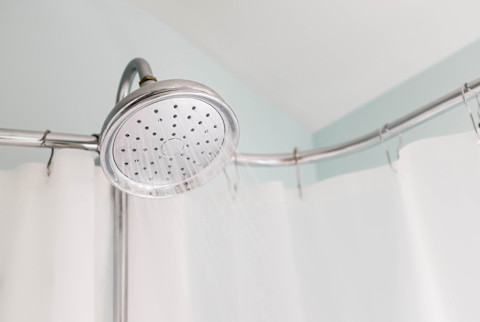How To Prevent & Treat Mold On Shower Curtains: An Expert's Top Tips

There’s nothing like hot, steam-filled showers to leave us feeling relaxed and refreshed. Unfortunately, they can quickly go from rejuvenating to risky since shower curtains are susceptible to mold growth. The good news is that preventing shower curtain mold is easier than you might think. Here are some best practices for keeping your bath time safe and sacred.
Why does mold form on shower curtains?
Mold usually forms on shower curtains in bathrooms that have poor airflow. The excess moisture located between the shower curtain and the shower liner can get trapped, creating an ideal environment for mold and mildew (which, by the way, should be taken just as seriously as mold) to grow.
How to prevent it:
Turn on the exhaust fan.
If you have an exhaust fan, running it is the easiest way to get the air in your bathroom flowing. However, it's worth noting that when you turn on your exhaust fan, you’re creating a negative pressure environment in your bathroom that sucks steam and air out. In order for your exhaust fan to properly work, you need to replace that air at the same rate you're pulling it out. This is why it's important to crack open a door or window every time you run it.
If you don't replace the airflow into the bathroom, your exhaust will not operate as efficiently as it could. Ever noticed moisture dripping from your fan after a hot shower? This is moisture that's been trapped inside the vent due to a lack of incoming air.
Separate your curtain and liner.
After your shower or bath, it's always best to leave the shower curtain outside the tub and the shower liner inside the tub so they are separated from one another. It's a simple step that's often overlooked.
By keeping them separate, you're allowing them both to dry properly. When these two wet surfaces are touching, moisture can persist between them for much longer. (Think about if you were to leave a wet sponge on a counter; both the sponge and the counter below it would remain damp for an extended period of time.)
Hang your mat.
That same moisture-trapping can happen when you leave your wet bath mat touching the floor. Simply prop your bath mat over the shower rod or a towel rack to allow it to fully dry between uses and you will have a lot less trouble with mold growing around your shower area.
Wash regularly.
Another helpful tip is to wash your bath mat and shower curtain regularly. Over time, dust will accumulate on both, and when dust accumulates, it provides a sort of magnet for settled mold spores to land on. In our home, we wash the shower curtains, liners, and bath mats as often as once a week.
How to get mold out of the shower.
Let's say you're too late and you already have mold on your bath mat, shower curtain, and/or shower liners. You can either remove it using a fabric cleaner that is proved to remove mold (this is the one I recommend) or replace them and be more diligent about preventing mold next time. Here are some more top tips for keeping every room in your home clean and mold-free.
